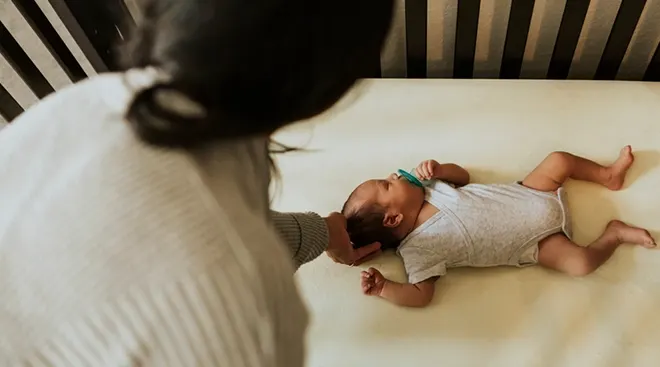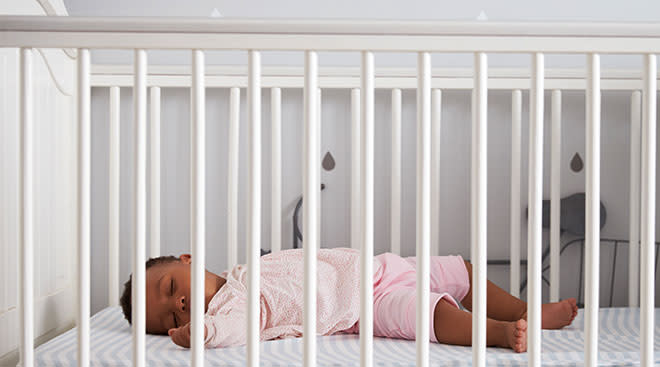Ditch Baby Hats for Pacifiers to Reduce SIDS Risk, Says AAP in Safe Sleep Update
The American Academy of Pediatrics (AAP) has released an update to its Safe Sleep Guidelines for the first time since 2016. Routinely refreshed every five years, the new guidelines acknowledge various dangers to safe sleep like co-sleeping and inclined sleepers and promote breastfeeding and pacifiers to decrease the risk of Sudden Infant Death Syndrome (SIDS) .
According to the AAP, approximately 3,500 infants die from sleep-related deaths annually in the United States. These heartbreaking deaths can occur when an infant with an intrinsic vulnerability to SIDS is placed in an unsafe sleep environment.
While overall numbers of SIDS deaths have declined, persistent racial and ethnic disparities exist. The rate of SIDS among Black and American Indian/Alaska Native infants was more than double and almost triple that of white infants in 2010-2013. The AAP hopes to increase parent awareness of safe sleep practices across all races and cultures with its new update so more SIDS deaths can be prevented.
Some of The Dangers The AAP Warns Against in The Update
-
Co-Sleeping. One of the most prominent updates to safe sleep guidelines concerns co-sleeping. The AAP stresses the importance of sharing a room with your sleeping infant for the first six months but not sharing your bed under any circumstances. “We know that many parents choose to share a bed with a child, for instance, perhaps to help with breastfeeding or because of a cultural preference or a belief that it is safe. The evidence is clear that this significantly raises the risk of a baby’s injury or death, however, and for that reason, AAP cannot support bed-sharing under any circumstances,” said statement and report co-author Rebecca Carlin, MD, in a press release. The update also points out that falling asleep with your baby on the sofa can be even more dangerous than drifting off in bed. According to the report, the risk of sleep-related infant death is 67 times higher when sleeping with someone on a couch or soft armchair.
-
Head Coverings. While adorable, the AAP recommends against using hats when indoors, outside of the first hours of life, as it can lead to your baby overheating. Studies have demonstrated an increased risk of SIDS when babies overheat while sleeping.
-
Weighted Items. An increasingly popular trend meant to sooth baby, the AAP recommends against using weighted blankets, sleepers, swaddles or other weighted objects. There is no evidence that swaddling can help prevent SIDS, and swaddling should be discontinued when infants start to roll.
-
Soft Bedding and Crib Bumpers. Keep soft objects, like pillows, quilts, mattress toppers, crib bumpers and loose bedding, such as blankets and nonfitted sheets, away from the infant’s sleep area to reduce the risk of SIDS. Airway obstruction from soft objects or loose bedding is the most common mechanism for accidental infant suffocation.
-
Inclined Sleepers. Recently banned along with crib bumpers, sleepers with an incline greater than 10 degrees can increase SIDS risk. Sitting devices, such as car seats, strollers, and swings, are not recommended for routine sleep, particularly for infants younger than four months.
Things the AAP Associates with a Reduced Risk of SIDS
-
Breastfeeding. Breastfeeding has been shown to reduce the risk of SIDS by almost 50 percent, with two months of at least partial breast milk feeding demonstrated to significantly lower risk.
-
Pacifiers. Although the reasoning is unclear, studies have reported offering a pacifier at nap or sleep time may reduce the risk of SIDS. The protective effect of the pacifier is observed even if it falls out of the infant’s mouth while sleeping. It is important not to attach the pacifier or hang it around the baby’s neck while sleeping as this could lead to a strangulation or suffocation risk.
-
Sleep on a firm noninclined surface According to the AAP, “The message from pediatricians has long been clear: the safest sleep environment for babies is a firm, flat, bare surface.”
Dr. Moon, a professor of pediatrics at the University of Virginia School of Medicine, summarizes the safe sleep update, saying, “A baby’s death is tragic, heartbreaking and often preventable. If we’ve learned anything, it’s that simple is best: babies should always sleep in a crib or bassinet, on their back, without soft toys, pillows, blankets or other bedding.”
If you’re looking for some ways to make sure you’re following safe infant sleep practices, check out our top 10 tips.
Please note: The Bump and the materials and information it contains are not intended to, and do not constitute, medical or other health advice or diagnosis and should not be used as such. You should always consult with a qualified physician or health professional about your specific circumstances.
Navigate forward to interact with the calendar and select a date. Press the question mark key to get the keyboard shortcuts for changing dates.





















































